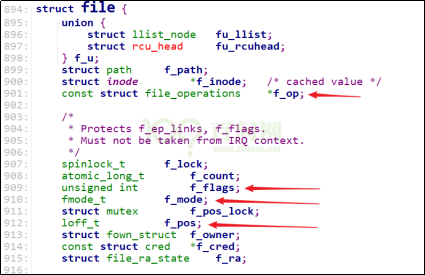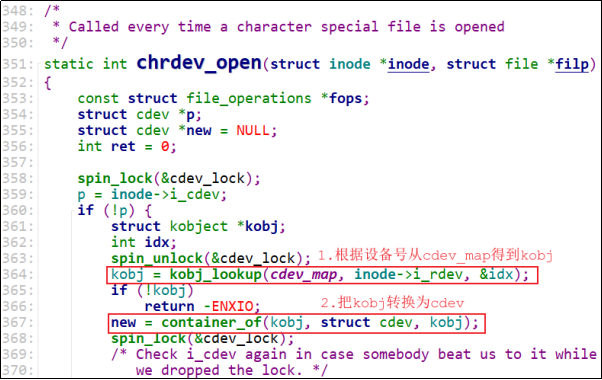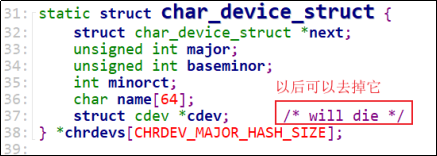Hello驱动(不涉及硬件操作)
本章节包含示例源码下载链接如下:
下载地址:Hello驱动源码
1.1 APP打开的文件在内核中如何表示
APP打开文件时,可以得到一个整数,这个整数被称为文件句柄。对于APP的每一个文件句柄,在内核里面都有一个“struct file”与之对应。

我们使用 open 打开文件时,传入的 flags、mode 等参数会被记录在内核中对应的struct file结构体里(f_flags、f_mode):
int open(const char *pathname, int flags, mode_t mode);
去读写文件时,文件的当前偏移地址也会保存在struct file结构体的f_pos成员里。

1.2 打开字符设备节点时,内核中也有对应的struct file
注意这个结构体中的结构体:struct file_operations *f_op,这是由驱动程序提供的。
驱动程序的struct file:

驱动程序的open/read/write:

结构体struct file_operations的定义如下:

1.3 怎么编写驱动程序
APP和驱动之间的简单对应关系为:

APP调用open函数时,内核会根据设备节点的主设备号找到驱动程序的 struct file_operations 结构体,然后调用它的 open 函数。以后APP调用 read/write/ioctl 等函数时,就会调用到驱动程序对应的 struct file_operations 结构体的 read/write/unlocked_ioctl 函数。
编写驱动程序的流程为: ① 确定主设备号,也可以让内核分配 ② 定义自己的 file_operations 结构体 ③ 实现对应的 drv_open/drv_read/drv_write 等函数,填入 file_operations 结构体 ④ 把 file_operations 结构体告诉内核:register_chrdev ⑤ 谁来注册驱动程序啊?得有一个入口函数:安装驱动程序时,就会去调用这个入口函数 ⑥ 有入口函数就应该有出口函数:卸载驱动程序时,出口函数调用 unregister_chrdev ⑦ 其他完善:提供设备信息,自动创建设备节点:class_create, device_create
1.4 编写代码
1.4.1 写驱动程序
参考内核driver/char中的程序,包含头文件,写框架,传输数据:
- 驱动中实现open, read, write, release,APP调用这些函数时,都打印内核信息
- APP调用write函数时,传入的数据保存在驱动中
- APP调用read函数时,把驱动中保存的数据返回给APP
hello_drv.c 源码如下:
01 #include <linux/module.h>
02
03 #include <linux/fs.h>
04 #include <linux/errno.h>
05 #include <linux/miscdevice.h>
06 #include <linux/kernel.h>
07 #include <linux/major.h>
08 #include <linux/mutex.h>
09 #include <linux/proc_fs.h>
10 #include <linux/seq_file.h>
11 #include <linux/stat.h>
12 #include <linux/init.h>
13 #include <linux/device.h>
14 #include <linux/tty.h>
15 #include <linux/kmod.h>
16 #include <linux/gfp.h>
17
18 /* 1. 确定主设备号 */
19 static int major = 0;
20 static char kernel_buf[1024];
21 static struct class *hello_class;
22
23
24 #define MIN(a, b) (a < b ? a : b)
25
26 /* 3. 实现对应的open/read/write等函数,填入file_operations结构体 */
27 static ssize_t hello_drv_read (struct file *file, char __user *buf, size_t size, loff_t *offset)
28 {
29 int err;
30 printk("%s %s line %d\n", __FILE__, __FUNCTION__, __LINE__);
31 err = copy_to_user(buf, kernel_buf, MIN(1024, size));
32 return MIN(1024, size);
33 }
34
35 static ssize_t hello_drv_write (struct file *file, const char __user *buf, size_t size, loff_t *offset)
36 {
37 int err;
38 printk("%s %s line %d\n", __FILE__, __FUNCTION__, __LINE__);
39 err = copy_from_user(kernel_buf, buf, MIN(1024, size));
40 return MIN(1024, size);
41 }
42
43 static int hello_drv_open (struct inode *node, struct file *file)
44 {
45 printk("%s %s line %d\n", __FILE__, __FUNCTION__, __LINE__);
46 return 0;
47 }
48
49 static int hello_drv_close (struct inode *node, struct file *file)
50 {
51 printk("%s %s line %d\n", __FILE__, __FUNCTION__, __LINE__);
52 return 0;
53 }
54
55 /* 2. 定义自己的file_operations结构体 */
56 static struct file_operations hello_drv = {
57 .owner = THIS_MODULE,
58 .open = hello_drv_open,
59 .read = hello_drv_read,
60 .write = hello_drv_write,
61 .release = hello_drv_close,
62 };
63
64 /* 4. 把file_operations结构体告诉内核:注册驱动程序 */
65 /* 5. 谁来注册驱动程序啊?得有一个入口函数:安装驱动程序时,就会去调用这个入口函数 */
66 static int __init hello_init(void)
67 {
68 int err;
69
70 printk("%s %s line %d\n", __FILE__, __FUNCTION__, __LINE__);
71 major = register_chrdev(0, "hello", &hello_drv); /* /dev/hello */
72
73
74 hello_class = class_create(THIS_MODULE, "hello_class");
75 err = PTR_ERR(hello_class);
76 if (IS_ERR(hello_class)) {
77 printk("%s %s line %d\n", __FILE__, __FUNCTION__, __LINE__);
78 unregister_chrdev(major, "hello");
79 return -1;
80 }
81
82 device_create(hello_class, NULL, MKDEV(major, 0), NULL, "hello"); /* /dev/hello */
83
84 return 0;
85 }
86
87 /* 6. 有入口函数就有出口函数:卸载驱动程序时就会去调用这个出口函数 */
88 static void __exit hello_exit(void)
89 {
90 printk("%s %s line %d\n", __FILE__, __FUNCTION__, __LINE__);
91 device_destroy(hello_class, MKDEV(major, 0));
92 class_destroy(hello_class);
93 unregister_chrdev(major, "hello");
94 }
95
96
97 /* 7. 其他完善:提供设备信息,自动创建设备节点 */
98
99 module_init(hello_init);
100 module_exit(hello_exit);
101
102 MODULE_LICENSE("GPL");
103
阅读一个驱动程序,从它的入口函数开始,第66行就是入口函数。它的主要工作就是第71行,向内核注册一个file_operations结构体:hello_drv,这就是字符设备驱动程序的核心。
file_operations 结构体 hello_drv 在第56行定义,里面提供了 open/read/write/release 成员,应用程序调用 open/read/write/close 时就会导致这些成员函数被调用。
file_operations 结构体 hello_drv 中的成员函数都比较简单,大多数只是打印而已。要注意的是,驱动程序和应用程序之间传递数据要使用 copy_from_user/copy_to_user 函数。
1.4.2 写测试程序
测试程序要实现写、读功能:
./hello_drv_test -w www.100ask.net // 把字符串“www.100ask.net”发给驱动程序
./hello_drv_test -r // 把驱动中保存的字符串读回来
hello_drv_test.c 源码如下:
02 #include <sys/types.h>
03 #include <sys/stat.h>
04 #include <fcntl.h>
05 #include <unistd.h>
06 #include <stdio.h>
07 #include <string.h>
08
09 /*
10 * ./hello_drv_test -w abc
11 * ./hello_drv_test -r
12 */
13 int main(int argc, char **argv)
14 {
15 int fd;
16 char buf[1024];
17 int len;
18
19 /* 1. 判断参数 */
20 if (argc < 2)
21 {
22 printf("Usage: %s -w <string>\n", argv[0]);
23 printf(" %s -r\n", argv[0]);
24 return -1;
25 }
26
27 /* 2. 打开文件 */
28 fd = open("/dev/hello", O_RDWR);
29 if (fd == -1)
30 {
31 printf("can not open file /dev/hello\n");
32 return -1;
33 }
34
35 /* 3. 写文件或读文件 */
36 if ((0 == strcmp(argv[1], "-w")) && (argc == 3))
37 {
38 len = strlen(argv[2]) + 1;
39 len = len < 1024 ? len : 1024;
40 write(fd, argv[2], len);
41 }
42 else
43 {
44 len = read(fd, buf, 1024);
45 buf[1023] = '\0';
46 printf("APP read : %s\n", buf);
47 }
48
49 close(fd);
50
51 return 0;
52 }
1.4.3 测试
- 编写驱动程序的Makefile
驱动程序中包含了很多头文件,这些头文件来自内核,在 ARM 平台上,不同厂商(如 Rockchip、Allwinner、Amlogic)对内核都有定制,因此驱动编译必须使用与当前系统完全匹配的内核头文件。 linux-headers-vendor-rk35xx_6.1.115-…… .deb 正是为 Armbian DshanPi-A1 提供这份匹配头文件的包,用于保证驱动能正确编译和加载。
linux-headers-vendor-rk35xx_6.1.115-…… .deb 下载链接如下:
下载地址:linux-headers-vendor-rk35xx_25.11.0-trunk_arm64_..>
执行以下指令安装 linux-headers-vendor-rk35xx_6.1.115-…… .deb :
sudo dpkg -i linux-headers-vendor-rk35xx_6.1.115-…… .deb
安装 linux-headers-vendor-rk35xx_6.1.115-…… .deb 之后,系统会在:
/lib/modules/$(uname -r)/build
建立一个指向对应内核头文件目录的符号链接(通常链接到 /usr/src/linux-headers-...)。
因此在编译外部驱动(如 DKMS 模块或手动编译的内核模块)时,只需指定:
make -C /lib/modules/$(shell uname -r)/build M=$(PWD) modules
要编译哪个文件?这也需要指定,设置 obj-m 变量即可。
要将 .c 文件编译为驱动模块 .ko,需要借助当前内核的构建系统,也就是 /lib/modules/$(shell uname -r)/build 下的 Makefile。
Hello 驱动和测试程序的 Makefile 内容如下:
# Makefile for hello_drv kernel module
# 模块名,不需要写 .c 后缀
obj-m := hello_drv.o
# 内核构建目录(自动指向当前运行内核的 headers)
KDIR := /lib/modules/$(shell uname -r)/build
# 当前路径
PWD := $(shell pwd)
# 默认目标:编译驱动模块 + 应用
all: module app
# 编译内核模块
module:
$(MAKE) -C $(KDIR) M=$(PWD) modules
# 编译应用程序
app:
$(CC) hello_drv_test.c -o hello_drv_test
# 清理目标文件
clean:
$(MAKE) -C $(KDIR) M=$(PWD) clean
rm -f hello_drv_test
- 上机实验
在相应路径下执行以下指令,编译、安装驱动和运行测试程序:
meihao@dshanpi-a1:~/KernelDemo/01_Hello$ ls
hello_drv.c hello_drv_test.c Makefile
# 编译内核和应用程序
meihao@dshanpi-a1:~/KernelDemo/01_Hello$ make
make -C /lib/modules/6.1.115-vendor-rk35xx/build M=/home/meihao/KernelDemo/01_Hello modules
make[1]: Entering directory '/usr/src/linux-headers-6.1.115-vendor-rk35xx'
CC [M] /home/meihao/KernelDemo/01_Hello/hello_drv.o
MODPOST /home/meihao/KernelDemo/01_Hello/Module.symvers
CC [M] /home/meihao/KernelDemo/01_Hello/hello_drv.mod.o
LD [M] /home/meihao/KernelDemo/01_Hello/hello_drv.ko
make[1]: Leaving directory '/usr/src/linux-headers-6.1.115-vendor-rk35xx'
meihao@dshanpi-a1:~/KernelDemo/01_Hello$ ls
hello_drv.c hello_drv.mod hello_drv.mod.o hello_drv_test Makefile Module.symvers
hello_drv.ko hello_drv.mod.c hello_drv.o hello_drv_test.c modules.order
# 安装驱动程序
meihao@dshanpi-a1:~/KernelDemo/01_Hello$ sudo insmod hello_drv.ko
meihao@dshanpi-a1:~/KernelDemo/01_Hello$ ls /dev/hello
/dev/hello
# 应用程序读写
meihao@dshanpi-a1:~/KernelDemo/01_Hello$ ./hello_drv_test
Usage: ./hello_drv_test -w <string>
./hello_drv_test -r
meihao@dshanpi-a1:~/KernelDemo/01_Hello$ sudo ./hello_drv_test -w dshanpi-a1
meihao@dshanpi-a1:~/KernelDemo/01_Hello$ sudo ./hello_drv_test -r
APP read : dshanpi-a1
1.5 Hello驱动中的一些补充知识
1.5.1 module_init/module_exit的实现
一个驱动程序有入口函数、出口函数,代码如下:
module_init(hello_init);
module_exit(hello_exit);
动程序可以被编进内核里,也可以被编译为ko文件后手工加载。对于这两种形式,“module_init/module_exit” 这2个宏是不一样的。在内核文件 “include\linux\module.h” 中可以看到这2个宏:
01 #ifndef MODULE
02
03 #define module_init(x) __initcall(x);
04 #define module_exit(x) __exitcall(x);
05
06 #else /* MODULE */
07
08 #define module_init(initfn) \
09
10 /* Each module must use one module_init(). */
11 static inline initcall_t __inittest(void) \
12 { return initfn; } \
13 int init_module(void) __attribute__((alias(#initfn)));
14
15 /* This is only required if you want to be unloadable. */
16 #define module_exit(exitfn) \
17 static inline exitcall_t __exittest(void) \
18 { return exitfn; } \
19 void cleanup_module(void) __attribute__((alias(#exitfn)));
20
21 #endif
编译驱动程序时,我们执行“make”这样的命令,它在编译c文件时会定义宏MODULE,比如:
gcc -DMODULE -c -o hello_drv.o hello_drv.c
在编译内核时,并不会定义宏MODULE。所以,“module_init/module_exit”这2个宏在驱动程序被编进内核时,如上面代码中第3、4行那样定义;在驱动程序被编译为ko文件时,如上面代码中第11~19行那样定义。
把上述代码里的宏全部展开后,得到如下代码:
01 #ifndef MODULE
01
01 #define module_init(fn)
02 static initcall_t __initcall_##fn##id __used \
03 __attribute__((__section__(".initcall" #6 ".init"))) = fn;
04
05 #define module_exit(x) static exitcall_t __exitcall_##x __used __section(.exitcall.exit) = x;
06
07 #else /* MODULE */
08
09 #define module_init(initfn) \
10
11 /* Each module must use one module_init(). */
12 static inline initcall_t __inittest(void) \
13 { return initfn; } \
14 int init_module(void) __attribute__((alias(#initfn)));
15
16 /* This is only required if you want to be unloadable. */
17 #define module_exit(exitfn) \
18 static inline exitcall_t __exittest(void) \
19 { return exitfn; } \
20 void cleanup_module(void) __attribute__((alias(#exitfn)));
21
22 #endif
驱动程序被编进内核时,把 “module_init(hello_init)”、“module_exit(hello_exit)” 展开,得到如下代码:
static initcall_t __initcall_hello_init6 __used \
__attribute__((__section__(".initcall6.init"))) = hello_init;
static exitcall_t __exitcall_hello_exit __used __section(.exitcall.exit) = hello_exit;
其中的“initcall_t”、“exitcall_t”就是函数指针类型,所以上述代码就是定义了两个函数指针:
- 第1个函数指针名为__initcall_hello_init6,放在段".initcall6.init"里;
- 第2个函数指针名为 __exitcall_hello_exit,放在段“.exitcall.exit”里。
内核启动时,会去段 ".initcall6.init" 里取出这些函数指针来执行,所以驱动程序的入口函数就被执行了。一个驱动被编进内核后,它是不会被卸载的,所以段“.exitcall.exit”不会被用到,内核启动后会释放这块段空间。驱动程序被编译为ko文件时,把 “module_init(hello_init)”、“module_exit(hello_exit)” 展开,得到如下代码:
static inline initcall_t __inittest(void) \
{ return hello_init; } \
int init_module(void) __attribute__((alias("hello_init")));
static inline exitcall_t __exittest(void) \
{ return hello_exit; } \
void cleanup_module(void) __attribute__((alias("hello_exit")));
分别定义了2个函数:
- 第1个函数名为init_module,它是hello_init函数的别名;
- 第2个函数名为cleanup_module,它是hello_exit函数的别名。
以后我们使用 insmod 命令加载驱动时,内核都是调用 init_module 函数,实际上就是调用 hello_init 函数;使用 rmmod 命令卸载驱动时,内核都是调用cleanup_module函数,实际上就是调用 hello_exit 函数。
1.5.2 register_chrdev的内部实现
register_chrdev 函数源码如下:
static inline int register_chrdev(unsigned int major, const char *name,
const struct file_operations *fops)
{
return __register_chrdev(major, 0, 256, name, fops);
}
它调用__register_chrdev函数,这个函数的代码精简如下:
01 int __register_chrdev(unsigned int major, unsigned int baseminor,
02 unsigned int count, const char *name,
03 const struct file_operations *fops)
04 {
05 struct char_device_struct *cd;
06 struct cdev *cdev;
07 int err = -ENOMEM;
08
09 cd = __register_chrdev_region(major, baseminor, count, name);
10
11 cdev = cdev_alloc();
12
13 cdev->owner = fops->owner;
14 cdev->ops = fops;
15 kobject_set_name(&cdev->kobj, "%s", name);
16
17 err = cdev_add(cdev, MKDEV(cd->major, baseminor), count);
18 }
这个函数主要的代码是第09行、第11~15行、第17行。
第09行,调用__register_chrdev_region函数来“注册字符设备的区域”,它仅仅是查看设备号(major, baseminor)到(major, baseminor+count-1)有没有被占用,如果未被占用的话,就使用这块区域。
为了便于理解,我们说内核里有一个 chrdevs 数组,根据主设备号 major 在 chrdevs[major] 中放入 file_operations 结构体,以后 open/read/write 某个设备文件时,就是根据主设备号从 chrdevs[major] 中取出 file_operations 结构体,调用里面的open/read/write函数指针。
上述说法并不准确,内核中确实有一个chrdevs数组:
static struct char_device_struct {
struct char_device_struct *next;
unsigned int major;
unsigned int baseminor;
int minorct;
char name[64];
struct cdev *cdev; /* will die */
} *chrdevs[CHRDEV_MAJOR_HASH_SIZE];
去访问它的时候,并不是直接使用主设备号 major 来确定数组项,而是使用如下函数来确定数组项:
/* index in the above */
static inline int major_to_index(unsigned major)
{
return major % CHRDEV_MAJOR_HASH_SIZE;
}
上述代码中,CHRDEV_MAJOR_HASH_SIZE 等于255。比如主设备号1、256,都会使用chardevs[1] 。chardevs[1]是一个链表,链表里有多个char_device_struct结构体,某个结构体表示主设备号为1的设备,某个结构体表示主设备号为256的设备。
chardevs的结构图如下:

从上图可以得出如下结论:
① chrdevs[i]数组项是一个链表头
链表里每一个元素都是一个char_device_struct结构体,每个元素表示一个驱动程序。 char_device_struct结构体内容如下:
struct char_device_struct {
struct char_device_struct *next;
unsigned int major;
unsigned int baseminor;
int minorct;
char name[64];
struct cdev *cdev; /* will die */
}
它指定了主设备号major、次设备号baseminor、个数minorct,在cdev中含有file_operations结构体。
char_device_struct 结构体的含义是:主次设备号为(major, baseminor)、(major, baseminor+1)、(major, baseminor+2)、(major, baseminor+ minorct-1)的这些设备,都使用同一个file_operations来操作。
为了更容易理解驱动程序时,说“内核通过主设备号找到对应的file_operations结构体”,这并不准确。应该改成:“内核通过主、次设备号,找到对应的file_operations结构体”。
② chardevs[1]中有3个驱动程序
- 第1个char_device_struct结构体对应主次设备号(1, 0)、(1, 1),这是第1个驱动程序。
- 第2个char_device_struct结构体对应主次设备号(1, 2)、(1, 2)、……、(1, 11),这是第2个驱动程序。
- 第3个char_device_struct结构体对应主次设备号(256, 0),这是第3个驱动程序。
- 第11~15行分配一个cdev结构体,并设置它:它含有file_operations结构体。
- 第17行调用cdev_add把cdev结构体注册进内核里。
cdev_add函数代码如下:
01 int cdev_add(struct cdev *p, dev_t dev, unsigned count)
02 {
03 int error;
04
05 p->dev = dev;
06 p->count = count;
07
08 error = kobj_map(cdev_map, dev, count, NULL,
09 exact_match, exact_lock, p);
10 if (error)
11 return error;
12
13 kobject_get(p->kobj.parent);
14
15 return 0;
16 }
这个函数涉及kobj的操作,这是一个通用的链表操作函数。它的作用是:把 cdev 结构体放入 cdev_map 链表中,对应的索引值是“dev”到 “dev+count-1”。以后可以从 cdev_map 链表中快速地使用索引值取出对应的cdev。
比如执行以下代码:
err = cdev_add(cdev, MKDEV(1, 2), 10);
其中的 MKDEV(1,2) 构造出一个整数 “1<<8 | 2”,即0x102;上述代码将 cdev 放入 cdev_map 链表中,对应的索引值是 0x102 到 0x10c(即0x102+10)。以后根据这10个数值(0x102、0x103、0x104、……、0x10c)中任意一个,都可以快速地从cdev_map链表中取出cdev结构体。
APP打开某个字符设备节点时,进入内核。在内核里根据字符设备节点的主、次设备号,计算出一个数值(major<<8 | minor,即inode->i_rdev),然后使用这个数值从 cdev_map 中快速得到 cdev,再从 cdev 中得到 file_operations 结构体。
关键函数如下:

在打开文件的过程中,可以看到并未涉及chrdevs,都是使用cdev_map。所以可以看到在chrdevs的定义中看到如下注释:

1.5.3 class_destroy/device_create浅析
驱动程序的核心是 file_operations 结构体:分配、设置、注册它。
“class_destroy/device_create” 函数知识起一些辅助作用:在/sys目录下创建一些目录、文件,这样Linux系统中的APP(比如udev、mdev)就可以根据这些目录或文件来创建设备节点。
以下代码将会在 “/sys/class” 目录下创建一个子目录 “hello_class”:
hello_class = class_create(THIS_MODULE, "hello_class");
以下代码将会在 “/sys/class/hello_class” 目录下创建一个文件“hello”:
device_create(hello_class, NULL, MKDEV(major, 0), NULL, "hello");
更详细的信息如下:
